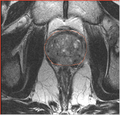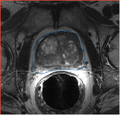2010 Summer Project Week Prostate MRI Segmentation
Key Investigators
- BWH: Andriy Fedorov
- GaTech: Yi Gao
Objective
Segmentation of the prostate gland is one of the steps in the planning of intra-operative guidance for image-guided biopsy and brachytherapy procedures. Accurate segmentation of the gland may be important for accurate calculation of the dose distribution in brachytherapy, and can be critical for accurate registration using surface-based approaches. We would like to automate the segmentation process, to reduce processing time, and improve its accuracy and reproducibility.
We will evaluate the applicability of the prostate segmentation tools developed by Georgia Tech (Yi Gao) on the 1.5T and 3.0T scans with and without endo-rectal coil.
Approach, Plan
This project is a follow-up on the previous developments in projects weeks of 2009-2010 (see references).
Our plan is to:
- make sure the software is compiled and applied correctly
- review processing pipeline
- evaluate the accuracy of segmentation compared with the manual outlines (we will use the publicly available dataset from MICCAI 2009 Prostate segmentation challenge (1.5T) as well as the images from on-going image-guided biopsy program at BWH (3T T2w, Siemens Magnetom)
Progress
- Evaluated new approach to segmentation developed by Yi Gao. Steps:
- register (up to bspline) each greyscale training image of the same modality to the subject
- average binary gland segmentations to obtain probability image
- initialize level set evolution with the voxels of high probability
- evolve contour under constraint of the spatial prior, intensity and curvature (parameters explored)
- Testing performed using the atlas constructed using MICCAI'09 challenge data (different field strength) for segmenting intra-procedural MRI w/o er-coil obtained at 3T
- Main challenges identified:
- inter-subject registration is very difficult, no robust solution found: this creates problems with initialization of the contour evolution
- with manual initialization, contour evolution has difficulties since prior is not well-aligned and intensity is highly non-uniform
- Future directions:
- incorporate shape constraint into the model
- consider edges in contour evolution?
Delivery Mechanism
This work will use the prostate segmentation tools earlier contributed to NAMIC Sandbox: http://viewvc.slicer.org/viewcvs.cgi/trunk/Queens/ProstateSeg


